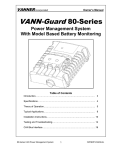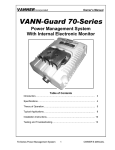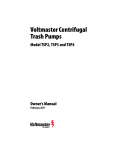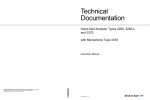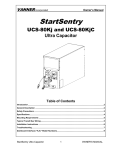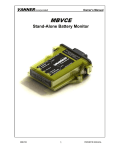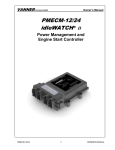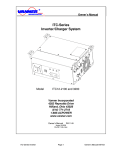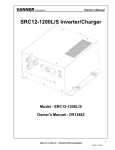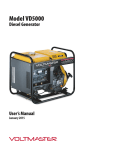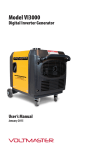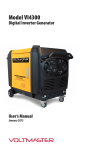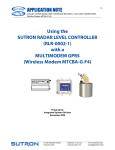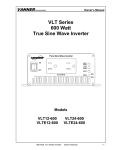Download Voltmaster T-Series Owner`s manual
Transcript
Owner’s Manual Incorporated VoltMaster Battery Equalizer 24 V Family 1 60-10B 60-20A 60-50A 60-50E 60-50M 12 V G ND Family 2 60-100C 60-100D 60-100E Family 3 60-60 60-60M 60-80 60-100 Family 4 65-60 65-60M 65-80 65-100 Family 5 66-60 66-80 66-100 Table of Contents Introduction………………………………………………….………………… 2 Specifications…………………………………………………….………….… 3 Theory of Operation……………...…………………………………………… 4 Typical Applications…………………………...…………….…………..…… 5 Installation Instructions………………………….………...…………………. 7 Testing and Troubleshooting………………………………………………… 9 Warranty……………………………………………………………………….. 15 BATTERY EQUALIZER 1 OWNER’S MANUAL Owner’s Manual Incorporated Introduction Thank you for purchasing a Vanner VoltMaster Battery Equalizer. We are confident that you will be very pleased with its performance because our Battery Equalizers are designed and manufactured by skilled professionals using the highest standards in workmanship. With minimum maintenance and care, you can be assured of many years of trouble free service. General Description The Vanner VoltMaster Battery Equalizer is an efficient and highly reliable method of obtaining a 12 volt DC power source from a 24 volt DC electrical system. The equalizer makes the batteries look like they are in series and parallel at the same time. In addition to providing regulated 12 volt power, the system ensures that battery voltages remain equal which significantly extends battery life. Ideally suited for vehicle and alternate energy applications, the VoltMaster Battery Equalizer is designed to save your batteries and the money you would spend replacing them. Users of the Vanner VoltMaster Battery Equalizer know that it is the most cost effective and dependable solution for dual voltage systems. A typical system would include a 24VDC power source, such as an alternator or solar array, two 12 volt battery banks in series, and the VoltMaster Battery Equalizer. The Battery Equalizer connects to the 24 volt, 12 volt and ground terminals of the battery system. When the 12 volt loads require power, the Battery Equalizer ensures that the current is taken equally from both batteries, and that the voltages of the two batteries are kept equal. This equalization ensures extended battery life and provides a stable 12 volt supply for operating accessories. Parallel Equalizers: Models are available which provide 10, 20, 60, 80 and 100 amps of 12 volt DC power. VoltMaster Battery Equalizers may also be operated in parallel to provide more power. For example, two 60 amp units can be installed to provide 120 amps of 12 volt DC power. Family 1, Family 3, Family 4, and Family 5 models may be paralleled in any combination. Family 2 models may be paralleled only with other Family 2 models. NOTE: The Vanner VoltMaster Battery Equalizer is an extremely reliable device and, when installed according to the instructions, will provide reliable operation for an indefinite period of time. However, if a system abnormality should develop that would cause a Battery Equalizer malfunction, damage to the battery system could result if 12 volt loads are present. If your system application is critical you may consider installing a Vanner Model EM-70 Electrical System Monitor. This module monitors the battery system's voltages and balance, and provides fault signals that can be wired to warning lights, buzzers or other control/warning devices. Models 60-50M , 60-60M and 65-60M have the EM-70 built in. Call Vanner for more details. BATTERY EQUALIZER 2 OWNER’S MANUAL Specifications Incorporated Specifications Family 1 Model Number Input Voltage 24v Efficiency (Peak) Max 24v Input Amps Output Voltage Output Amps (12v) Standby Current Operating Temp. Storage Temp. Serviceable Environmental Considerations Mounting Location Weights 60-10B >91% 60-20A Family 2* 60-50A* 60-100E* 20 to 35v >92% >92% 6 12 Family 3* / Family 4 60-60* 60-80* 65-60 Family 5 60-100* 65-80 65-100 66-60 18 to 36v >94% >97.5% 18 to 32v >97.5% >97.5% >97% 55 32 43 53 32 28 66-80 66-100 18 to 32 v >97% >97% 43 53 (Input Voltage/2) ±2% - 50mv 0-10 0-20 0-50 0-100 0-60 0-80 0-100 0-60 0-80 17 milliamps nominal at 28.4V -40°C to +71°C (-40°F to 160°F) -40°C to +75°C (-40°F to 167°F) -54°C to +85°C (-65°F to 185°F) -54°C to +95°C (-65°F to 203°F) Yes Yes Yes Yes No No No No No 0-100 No Anodized aluminum enclosure provides protection against salt, fungus, dust, water, fuel vapors and all fluids associated with commercial and off-highway vehicle operations. Continuous exposure to splashes and spills should be avoided. Mount on a flat surface close to the batteries to allow short cable runs. Vertical mounting with terminals down is recommended. Location should be protected from battery acid and gases. 2.3 lbs 5.0 lbs 7.0 lbs 9.5 lbs 6.0 lbs 6.6 lbs 6.6 lbs 6.0 lbs 7.0 lbs 7.6 lbs 7.6 lbs 6.3 lbs 6.3 lbs Unlisted models: Model 60-60M and 65-60M have built-in EM-70 Electrical System Voltage Monitor. Model 60-50M is a 60-50A with built-in EM-70. Model 60-50E is a 60-50A with weather resistant gasket. Model 60-100C is an early 60-100E. Model 60-100D is a 60-100C with circuit breakers instead of internal fuses. Older models not listed in the above table should be tested as Family 1 and should be considered non-repairable. *Obsolete. Family 1 and Family 2 Equalizer Dimensions FA M IL Y 1: 1/4"-2 8 S TU D (X 3) TO RQ U E 60 IN-LB S M A X. "B " "C " "D " FA M IL Y 2: 3/8"-2 4 S TU D (X 3) TO RQ U E 150 IN-LB S M A X. GND 8.50" (216.0) +1 2V 8.00" (203.3) 7.40" (188.0) +2 4V .25" (6.35) .25" (6.35) "A " Model 60-10B 60-20A 60-50A 60-100C “A” 4.25 (107.9) 9.38 (238.2) 13.38 (339.8) 13.46 (341.88) BATTERY EQUALIZER “B” 3.00 (76.3) 8.00 (203.2) 12.00 (304.8) 12.00 (304.8) 3 3.20" (81.3) 3.82" (97.03) “C” 2.00 (50.80) 4.50 (114.3) 8.00 (203.2) 8.00 (203.2) “D” 0.50 (12.7) 1.75 (44.4) 2.00 (50.8) 2.00 (50.8) OWNER’S MANUAL Specifications Incorporated Family 3 Equalizer Dimensions 9.00" (228.7) .50" (12.7) 8.00" (203.3) Family 4 and Family 5 Dimensions 2.50" (63.5) 8.00 (203.2) 10.50 (255.6) 9.13 (231.7) 0.56 (14.3) 2.47 (62.74) +24V 8.50" (216.0) GND 7.94 (201.7) 8.00" (203.3) 8.50 (215.9) +12V .25" (6.35) 5-16"-18STUD(X3) TORQUE120 IN-LBSMAX. 0.28 (7.1) 5-16"-18 STUD (X3) TORQUE 120 IN-LBS MAX. ___________________________________________________________________ Theory of Operation In many 24 volt electrical systems it is desirable to tap into the battery system to obtain power for 12 volt loads. This method, while seemingly simple, causes a charge imbalance resulting in Battery B (see diagram) being overcharged, and possibly boiling, while Battery A discharges. To solve this application problem the Vanner VoltMaster Battery Equalizer is connected to the battery system at the +24 volt, +12 volt, and ground points. The Battery Equalizer makes the batteries look like they are in series and in parallel at the same time. The Battery Equalizer maintains the voltage balance and therefore the charge acceptance rate of each battery. Family 3 and Family 4 Equalizers hold Battery A and B voltages to within 0.05 volts under light loads and to within 0.1 volts at full rated load. Family 1 and Family 2 models hold Battery A and B voltages to within 0.10 volts under light loads and to within 0.50 volts under full rated load. +24V + 12V Battery B +12V + 24V ALT. +24 Volt Loads +12 Volt Loads F2 +24V VANNER Battery Equalizer F1 + 12V Battery A - +12V GND _ Note-Battery Banks A and B should have the same amp-hour capacity. When the voltage of Battery A is higher than or equal to Battery B the Battery Equalizer is in the standby mode, i.e., it is not transferring power from its 24 volt input to its 12 volt output. When a 12 volt load is present, and Battery A's voltage decreases to just below the voltage of Battery B, the Battery Equalizer activates and transfers sufficient current from Battery B to Battery A to satisfy the load and maintain an equal voltage and charge in both batteries. A key advantage of a system containing a Vanner VoltMaster Battery Equalizer, compared to a DC to DC converter, is that if the 12 volt load requires a momentary surge current which exceeds the rated capacity BATTERY EQUALIZER 4 OWNER’S MANUAL Typical Applications Incorporated of the Battery Equalizer, Battery A will supply the extra current to the load. The Battery Equalizer will then replenish the energy to Battery A after the surge has passed. The VoltMaster Battery Equalizer is a completely automatic device that requires no human intervention when installed according to the recommended procedures. Family 1 Equalizers and some Family 2 Equalizers have a manually resetable circuit breaker. If the circuit breaker trips, due to a system overload or abnormality, it can be reset by pushing the white button. Note that on some units the white circuit breaker button may protrude slightly in its normal (non-tripped) position. A blown fuse on Family 2 Equalizers requires factory repair. There are no user operational devices on Family 3, Family 4 or Family 5 models. The following scenarios describe the VoltMaster Battery Equalizer's system operation. Scenario #1 - 24 volt load present, no 12 volt load present. The system operates as a system would without the Battery Equalizer whether the alternator is ON or OFF. The Battery Equalizer is in the standby mode except for making small adjustments to keep the batteries in balance. Scenario #2 - Both 24 volt and 12 volt loads present, alternator is OFF. The Battery Equalizer will insure that both batteries will discharge at the same rate even if different loads are present. Scenario # 3 - Both 24 volt and 12 volt loads present, alternator is ON. The alternator provides 24 volt power to the battery system and to the 24 volt loads. The Battery Equalizer transfers power from the 24 volt source to the 12 volt load by converting 24 volt power to 12 volts. It will supply sufficient 12 volt power to satisfy the 12 volt load and to maintain battery voltage balance. _____________________________________________________________________ Typical Applications Vanner VoltMaster Battery Equalizer are used in many types of applications including transit and tour buses, private coaches, heavy trucks and off highway equipment, yachts, and alternative energy systems such as solar powered homes. In addition to Battery Equalizers, Vanner manufactures a wide range of complementary products such as DC to DC converters, DC to AC inverters, battery charger/conditioners, and battery isolators. The following system diagrams illustrate how these products are used in various applications. TRANSIT BUS +24V + 12V Battery B +12V + 24V ALT. +24 Volt Loads +12 Volt Loads F2 +24V VANNER Battery Equalizer F1 + 12V Battery A - +12V GND _ BATTERY EQUALIZER 5 OWNER’S MANUAL ! Typical Applications Incorporated PRIVATE COACH Battery Isolator or Paralleling Switch HOUSE BATTERY SYSTEM COACH BATTERY SYSTEM +24V F2 F2 +24V +24V + 12V Battery B +12V + +24 Volt Loads 24V ALT. F1 +12V +12V + 12V Battery A - +12 Volt Loads + 12V Battery B - VANNER Battery Equalizer GND +12 Volt Loads _ F1 +24V VANNER Battery Equalizer + 12V Battery A - + - +12V GND VANNER DC to AC Inverter 120VAC To AC Loads TOUR/CHARTER COACH +24V F2 +24V + 12V Battery B +12V + +24 Volt Loads 24V ALT. VANNER Battery Equalizer + F1 +12 Volt Loads - +12V + 12V Battery A - VANNER DC to AC Inverter GND 120VAC To AC Loads _ MARINE Battery Isolator or Paralleling Switch ENGINE BATTERY SYSTEM HOUSE BATTERY SYSTEM +24V F2 F2 +24V + 12V Battery B + + 24V ALT. 24V Starter _ _ +12V +12 Volt Loads F1 + 12V Battery A - +24V VANNER Battery Equalizer +12V GND To 24V House Loads To 12V House Loads + 12V Battery B F1 + 12V Battery A - +24V VANNER Battery Equalizer +12V GND + - VANNER Battery Charger From Main AC Panel + VANNER DC to AC Inverter To Automatic Transfer Switch Engine Controls Navigation Systems Communications Equip. BATTERY EQUALIZER 6 OWNER’S MANUAL "#$$%& Installation Incorporated Installation Instructions When connecting wires or cables to the available post (+24, GND, +12) when installing Vanner Equalizer Models 60-60, 60-80, 60-100, do not exceed the specified torque of 120 in-lbs. This information is printed on the Product Label just above the connection post. Torque values higher than specified may damage the product, reducing performance or creating hazardous conditions. Products damaged by improper torque may not be covered by warranty. Do not connect more than one conductor per available post on any model of Vanner Equalizer. Multiple wires and cables may overstress internal components, resulting in poor performance or creating hazardous conditions. Products damaged by the installation of multiple conductors per post may not be covered by warranty. Fault protection devices must be installed between the Equalizer and the power source (battery). A fault protection device would be any fuse or circuit breaker properly rated for the maximum DC current obtainable. This advisory is in accordance with SAE, NEC and UL, for mobile power applications. Install per applicable codes or within 18” of the battery. See Wire and Fuse Sizing Chart on page 9 of this manual or contact Vanner at 1-800-227-6937 or [email protected] if assistance is needed in sizing fault protection devices. Caution: This equipment employs components that tend to produce arcs and sparks. To prevent fire or explosion, do not install in compartments containing batteries or flammable materials. Safety goggles should always be worn when working near batteries Mounting Location –The Equalizer may be mounted in any orientation, however, the recommended orientation for optimum heat dissipation is vertical. It is recommended that the wiring terminals be down to prevent the possibility of a falling metal object shorting the terminals. Do not mount in zero-clearance compartment that may result in the Equalizer overheating. Locate so that contact by people is unlikely. Environmental Protection – Do not expose to rain or moisture. The unit should be located in an area that will protect it from direct exposure to moisture such as high pressure washing, rain, etc. Wiring Sequence– To prevent reverse polarity damage on Family 1 and Family 2 models when connecting/disconnecting battery terminals: ALWAYS 1) Remove Equalizer ground terminal first, and 2) Replace Equalizer ground terminal last. The wiring sequence is not an issue with Family 3 or 4 models. Equalizer Models 60-50M, 60-60M and 65-60M with built-in EM-70 Battery Monitor F2 +2 4 V (W H T ) +2 4 V IG N . R E D (B A T T . B A L .) B L K (B A T T . H I) G R N (B A T T . LO ) + VO LT AG E FO R LAM PS GND +1 2 V 2 4V - BATT A + F1 - BATT B + O P TIO N A L LO AD LOA D D IS C O N N E C T S W ITC H E S B A TTE R Y M O N ITO R + 2 4V A L T - C O N T R O L IN P U T : +2 4V D C O U T P U T : 0 .3 7 5 A M P S (P E R T E R M .) T R IP L E V E LS : (A L L H A V E 5 S E C . D E L A Y ) B A T T E R Y B A L A N C E IN P U T V O LT A G E .. 2V + /-6 % B A T T E R Y S Y S T E M H IG H 3 0.3 V B A T T E R Y S Y S T E M L O W 23 .7 V 1 2V LO AD The EM-70 Battery Monitor provides the following ground signals: Battery HI when +24 rises above 30.3V, Battery LO when +24 falls below 23.7V, Battery BALANCE when +12 is not within 6% of (+24 ÷ 2). Each ground signal is rated 0.375 amps and should be protected by a 1 amp fuse. BATTERY EQUALIZER 7 OWNER’S MANUAL '())*+ Installation Incorporated Caution adding 12volt batteries +24V + 24V ALT. _ F2 +24V + VANNER 12V Battery B Battery Equalizer + 12V Battery A - +12V GND +24V BATTERY A AND BATTERY B ARE THE SAME SIZE. +12V F1 + 12V Battery - + 12V Battery - +24V + VANNER 12V Battery B Battery Equalizer + + 12V Battery A - 24V ALT. _ +12 Volt Loads BATTERY A AND BATTERY B ARE NOT THE SAME SIZE. +12V GND +12V + 12V Battery A - + 12V +12 Volt Battery A Loads UNACCEPTABLE- BATTERY B WILL BECOME OVERCHARGED IF THE EQUALIZER CANNOT KEEP UP WITH THE ALTERNATOR. ACCEPTABLE - BATTERY A AND BATTERY B ARE THE SAME SIZE. In certain applications, such as private coach or alternate energy applications, it may be desirable to have additional 12 volt “House Batteries” to operate heavy 12 volt (inverter) loads. Use the Equalizer to charge the additional batteries. Connect the Equalizer 12V terminal to the additional batteries only. Do not connect the Equalizer 12V terminal to both battery banks as this would make Battery A larger than Battery B. Damage to Battery B may occur during charging due to overcharging, if the equalizer cannot keep up with the charging system. Caution using a Ground-Side Battery Disconnect Switch +24V HIGH CURRENT DIODE +12V + 24V ALT. _ +24 Volt Loads + 12V Battery B F1 + 12V Battery A - +12 Volt Loads (Radio) F2 +24V VANNER Battery Equalizer +12V GND BATTERY DISCONNECT SWITCH The system must be wired as shown to prevent Reverse Polarity Damage to polarity sensitive12 volt loads and Family 1 and Family 2 Equalizers while the ground-side disconnect switch is open. The equalizer'sGND terminal must be wired to the battery side of the ground-side disconnect switch circuit for the equalizer to work properly. Install the external High Current Diode, such as Vanner Model 52-75 (45 amp continuous rating) to protect polarity sensitive 12 volt loads if these loads do not already contain input diode protection. This prevents a reverse polarity on the 12 volt equipment when the battery switch is open. The reverse polarity does not come from the Equalizer but from any 24 volt equipment that may be turned ON. Wire Size and temperature rating Cables connecting the Battery Equalizer to the batteries must be sufficiently large to prevent unwanted voltage drops. These voltage drops (loss) must be less than 0.05 VDC between the Equalizer's +24 volt terminal and the battery +24 volt terminal (Battery B positive terminal), less than 0.10 VDC between the Equalizer's +12 volt terminal and the battery +12 volt terminal (the jumper between Battery A and Battery BATTERY EQUALIZER 8 OWNER’S MANUAL ,-../0 Testing and Trouble Shooting Incorporated B), and less than 0.05 VDC between the Equalizer'sGND terminal and the battery ground terminal (Battery A negative terminal that is connected to chassis ground). In most installations, the Battery Equalizer's terminals are wired directly to the battery terminals to prevent voltage loss that could occur in switch contacts, connections, and long wire runs. Since the equalizer can be operated in temperatures up to 71º or 75ºC, use wire rated at least 90ºC. See Wire and Fuse Size Chart. Wire and Fuse Size Chart Wire Size AWG #14 #12 #10 #8 #6 #4 #2 #1 #1/0 #2/0 Ring Terminal Molex or UL recognized equal 191930072 191930134 191930134 191930157 191930251 191930278 191930309 191930333 191930333 191930346 Fuse F1 Fuse F2 Max wire length, in feet, between Equalizer and battery to keep voltage drop under 0.1 volt. The chart assumes wire carries no other load and wire temperature is below 80ºC. 60-10 60-20 60-50 3.2 5.0 7.7 12.8 19.4 35.2 51.9 65.4 82.9 105.5 20 amp 10 amp XXX 2.5 3.8 6.4 9.7 17.6 26.0 32.7 41.4 52.7 30 amp 15 amp XXX XXX XXX 2.6 3.9 7.0 10.4 13.1 16.6 21.1 80 amp 35 amp 60-60 65-60 66-60 XXX XXX XXX 2.1 3.2 5.9 8.7 10.9 13.8 17.6 80 amp 40 amp 60-80 65-80 66-80 XXX XXX XXX XXX 2.4 4.4 6.5 8.2 10.4 13.2 100 amp 50 amp 60-100 65-100 66-100 XXX XXX XXX XXX XXX 3.5 5.2 6.5 8.3 10.5 125 amp 80 amp 2 x 60-100 2 X 65-100 2 X 66-100 XXX XXX XXX XXX XXX XXX 2.6 3.3 4.1 5.3 250 amp 150 amp Crimp the ring terminals using Molex tool 192840002 (14ga), 192840001 (10 -12ga), 192840035 (2 - 8ga) (phone 813-521-2700) and AC Terminal tool model 0280 (6 ga and larger) (phone 614-868-9828). ___________________________________________________________________ Testing and Troubleshooting All Vanner equalizers fall into one of three distinct families. The three families operate differently and must be tested differently. The following three test procedures apply only to the equalizer family listed. Before testing the equalizer, be sure all battery connections are good and that fuses F1 and F2 are good. CAUTION Servicing of electrical systems should only be performed by trained and qualified technical personnel. Equipment Required VoltMeter having 0.01 volt resolution. (Fluke Model 87 Multimeter recommended). Clamp-on amp meter (Fluke Model 36 Clamp-on Meter recommended). Vanner Repair Service Vanner offers a quick turn around factory repair service for Family 1 and Family 2 models. (Family 3, 4 and 5 models are non-repairable.) Send the unit to the address below with a note instructing us to repair it. Include your name, phone number, shipping address (not a P.O. Box Number), and your purchase order number. BATTERY EQUALIZER 9 OWNER’S MANUAL 123345 Testing and Trouble Shooting Incorporated Test Procedure for Family 1 Battery Equalizers Models 60-10B, 60-20A, 60-50A CAUTION To avoid Reverse Polarity Damage to Family 1 and Family 2 Equalizers when servicing the electrical system or when performing any work which involves making battery connections always: 1. Remove Equalizer Ground terminal first. 2. Replace Equalizer Ground terminal last. Family 1 Battery Equalizer Test Procedure: 1. Carefully remove the ground (GND) cable from the Equalizer. Do not allow this cable to touch any other connection on the Equalizer because the other terminals are connected to the batteries. 2. Make sure there is approximately 12 volts between the +24 and +12 terminals of the Equalizer by momentarily connecting the two terminals of a 12 volt light (headlight, marker light, etc.) to the +24 and +12 terminals of the Equalizer. The light should light and stay lit. 3. Next, connect that same 12 volt lamp between the +12 and GND terminals of the Equalizer. The lamp should light and stay lit. If the lamp does not light, the light then goes out, or the light dims, the Equalizer requires repair. 4. Further verification may be made by measuring the voltages on the Equalizer terminals. Be certain that the lamp used earlier is connected between the +12 and GND terminals. 5. Measure the voltage between +24 and +12 terminals. Note this reading. 6. Measure the voltage from the +12 terminal to GND. Note this reading. 7. Compare the two readings by subtracting the +12 to GND reading from the +24 to +12 reading. A properly functioning Equalizer is one where the difference is between -0.5 and +0.13 volts. For example, the +24 to +12 reading might be 12.85 volts. The +12 to GND voltage might read 12.75 volts. This Equalizer would be functioning properly with a 0.10 difference (12.85 minus 12.75 volts) which is within specs. Common Questions for Family 1 Battery Equalizers Q) Will operating loads which exceed the output rating of the Battery Equalizer cause the circuit breaker (white button near the wiring terminals on Family 1 or Family 2 equalizers) to trip? BATTERY EQUALIZER 10 OWNER’S MANUAL 67889: Testing and Trouble Shooting Incorporated A) No, the Battery Equalizer electronically limits the output current to a value less than the amount required to trip the circuit breaker. (Extreme conditions, such as 28 VDC input with 8 VDC output at very high ambient temperatures, may cause the circuit breaker to trip.) Q) Why is the Battery Equalizer's circuit breaker value lower than its output current rating (35 amp circuit breaker in model 60-50A)? A) The circuit breaker is in the ground circuit. Due to the equalizer’s two to one (24/12 VDC) voltage conversion, the model 60-50A requires 25 amps at 24VDC input to produce about 50 amps output at 12 VDC. Therefore, a 35 amp circuit breaker in the GND circuit will properly protect for the maximum 25 amp rating. Q) What causes the circuit breaker to trip on a Battery Equalizer? A1) The Battery Equalizer's circuit breaker is designed to trip when the +12 volt toGND terminals are exposed to reverse polarity. A2) With the Battery Equalizer'sGND terminal connected to chassis and the battery negative terminal disconnected, a short between a +24 volt circuit and chassis will pull the chassis up to +24 volts, causing a reverse polarity on the +12 volt to GND circuits. The circuit breaker trips to protect the Battery Equalizer. A3) With the Battery Equalizer'sGND terminal connected to chassis and the battery negative cable disconnected, 24 volt loads (e.g., starter motor) will pull the chassis up to +24 volt causing a reverse polarity on the Battery Equalizer's +12 Volt toGND circuits. The circuit breaker will trip to protect the Battery Equalizer. A4) Since the above reverse polarity conditions may occur during bus maintenance it is recommended that the service personnel verify the circuit breaker is IN before releasing the bus for service and the tour bus operator do the same in his “walk around”. Q) What are some known conditions that could cause Battery Equalizer problems? A1) Corrosive liquids or water forced into the Battery Equalizer's case from high pressure spray cleaning could shorten the normal life expectancy. A2) Drilling into the case (except for the mounting flanges) can shorten the life or prevent the unit from operating. The installer may not realize the Battery Equalizer is not operating correctly unless a 12 volt load is applied to the system and the Battery Equalizer 12 volt current is measured. A3) Too small of wire or bad connections will allow the Battery balance to be less than optimum. Voltage loss in wire from the battery's +24 volt terminal to the Battery Equalizer's +24 volt terminal should be 0.05 VDC maximum; from the battery's +12 volt terminal to the Battery Equalizer's +12 volt terminal should be 0.10VDC maximum, and from the battery ground terminal to the Battery Equalizer'sGND terminal should be 0.05 VDC maximum, when the +12 volt load is causing the Battery Equalizer to operate at 100% capacity. A4) Installing the Battery Equalizer in a location where it will be exposed to battery fumes will shorten its normal life. Acid fumes are heavier than air. Installation of Battery Equalizers on the battery mounting surface near the bottom of the batteries have caused severe corrosion to the Battery Equalizers. However, installation of Battery Equalizers 3 or more inches above the top of the batteries have not caused problems. Q) Can different models of equalizers be paralleled? A) Yes, any combination of models from Family 1, Family 3 and Family 4 may be paralleled. Family 2 models may only be paralleled with other Family 2 models. BATTERY EQUALIZER 11 OWNER’S MANUAL ;<==>? Testing and Trouble Shooting Incorporated Test Procedure for Family 2 Battery Equalizers 24V 12V GND Models 60-100C, 60-100D and 60-100E General: Family 2 Equalizers were designed to be more energy conservative during low power requirements compared to Family 1 models. This along with unique protection circuitry require Family 2 models to be tested differently than Family 1, or Family 3, 4 and 5 models. CAUTION To avoid Reverse Polarity Damage to Family 1 and Family 2 Equalizers when servicing the electrical system or when performing any work which involves making battery connections always: 1. Remove Equalizer Ground terminal first. 2. Replace Equalizer Ground terminal last. Family 2 Battery Equalizer Test Procedure: 1. With the coach engine and vehicle loads OFF measure the voltage of Battery A. Replace or recharge Battery A if less than 11.5 volts. 2. Start the engine and turn ON a 12 volt load such as headlights. 3. Measure the input voltage between the +24 and GND posts of the equalizer. This voltage should be between 25.5 volts and 29.0 volts. If it isn’t then check the alternator and 24 volt voltage regulator circuits. 4. Zero the DC Clamp-on ammeter as needed. 5. Put the jaws of the clamp-on ammeter around all wires connected to the equalizer +12 volt terminal stud. 6. Observe the DC amperage out of the equalizer with the clamp-on ammeter. If there are 3 amps or more showing on the ammeter, the equalizer is functioning and no further tests are needed. 7. Continue with the following steps ONLY if the ammeter shows less than 3 amps. 8. Measure the voltage between the +24 terminal (meter positive lead) and the +12 terminal (meter negative lead) of the equalizer. Record this voltage. 9. Subtract 0.60 volts from the number recorded in Step 8. 10. Measure the voltage between the equalizer +12 terminal (meter pos) and the GND terminal (meter neg). 11. Wait for this voltage to drop below the voltage calculated in Step 9 or the clamp-on ammeter reading jumps from approximately 0 to more than 3 amps. More than 3 amps means the equalizer is functioning. BATTERY EQUALIZER 12 OWNER’S MANUAL @ABBCD Testing and Trouble Shooting Incorporated 12. If the voltage drops below the calculated value from Step 9 and the clamp-on ammeter has not jumper from approximately 0 to more than 3 amps of current wait for an additional 30 seconds. 13. If the equalizer does not turn ON after 30 seconds the unit is defective and should be sent in for repair. Test Procedure for Family 3, 4 & 5 Battery Equalizers Models 60-60, 60-80 and 60-100 Models 65-60, 65-80, 65-100 Models 66-60-66-80, 66-100 General: Family 3, Family 4 and Family 5 Equalizers contain an indicator light. If the indicator light is ON the equalizer is working. The Equalizer is working properly if: 1. The Indicator Light is ON and; 2. The 12 volt DC loads are being operated continuously and are within the rated capacity of the equalizer and; 3. Battery A voltage is lower than Battery B by no more than 0.05 to 0.10 volts (measured at the equalizer +24, +12 and GND terminals). Family 3, 4 and 5 Battery Equalizers are electronically protected against reverse polarity damage therefore the DC connection sequence is not an issue. Family 3, 4 and 5 Equalizers will not function properly unless all three battery connections are made. Battery A and Battery B voltages both must be above 8 volts for the unit to turn ON. Any combination of Family 1, Family 3, Family 4 and Family 5 models may be operated in parallel. Please note that the 24V, 12V and GND stud position and orientation are different on Family 3, 4 and 5 models than on Family 1 or Family 2 models. Family 3, Family 4 and Family 5 Battery Equalizer Test Procedure: 1. Field test the equalizer while fully connected to the vehicle batteries. For bench testing, two 12 volt batteries, or two 12 volt power supplies are required. Family 3, 4 and 5 Equalizers must be connected to the batteries at GND, 12V and 24V to function properly. 2. If battery voltage is below 24 volts start the vehicle or apply a 24 volt battery charger to the batteries. 3. Turn ON 12 volt DC loads up to the equalizer rated capacity. Measure DC amps on the equalizer +12 cable to verify load amperages. 4. At the equalizer measure and record: a. Battery A voltage (voltage between the equalizer +12 and GND terminals) b. Battery B voltage (voltage between the equalizer +24 and +12 terminals) c. Equalizer Indicator Light status (ON or OFF) BATTERY EQUALIZER 13 OWNER’S MANUAL EFGGHI 5. Subtract Battery A voltage from Battery B voltage and compare readings. Voltage Comparison a. b. c. d. e. Testing and Trouble Shooting Incorporated Battery A is lower than Battery B but within 0.05 volt. Battery A is lower than Battery B by 0.05 to 0.10 volts. Battery A is lower than Battery B by more than 0.10 volts Battery A is lower than Battery B by more than 0.10 volts Battery A is higher than Battery B Indicator Light Equalizer Status OFF OFF ON ON ON ON OFF OFF Stand-by Mode. The equalizer will not turn ON until Battery A is lower than Battery B by more than 0.05 volts. Normal Operating Mode Self-Protection Mode due to Overload Condition. See below. The Equalizer is not functioning properly. Abnormal condition. Suspect Battery B is defective or a 12 volt load is connected to Battery B. Overload Condition on Family 3, Family 4 and Family 5 Equalizers An overload condition exists when the 12 volt loads exceed the equalizer’s rated capacity. The overload condition will not damage the equalizer but may cause damage to the batteries. During the overload, the equalizer output is limited by internal protection circuits to its Rated Output Amps. The 12 volt amps exceeding the equalizer output are drawn from Battery A which will begin to draw the batteries out of balance. The equalizer full Rated Output Amps are maintained as long as Battery A and Battery B remain balanced within 0.10 volt. The internal protection circuits will reduce equalizer output as the batteries become further out-of-balance. If Battery A voltage falls below approximately 8 volts the equalizer will shut itself OFF. To correct the overload condition the 12 volt load must be reduced or the equalizer capacity must be increased. Trouble Shooting an Engine No-Start Situation Situation: A coach has dead batteries and won’t start while jump starting. The coach is equipped with a 24 volt starting and charging system, a 12 volt electronic diesel engine control, a Family 3, 4 or 5 Equalizer, and a moderate 12 volt load which cannot be turned OFF. The coach sits for several days and the batteries run completely dead. During jump starting the engine cranks but does not start due to low voltage on the 12 volt supply. Electrical testing reveals there is no 12 volt output from the equalizer while jump starting even though the equalizer separately tests OK. Cause: The 12 volt load which could not be turned OFF first ran both batteries down until the equalizer shut itself OFF due to low voltage. (Family 3, 4 and 5 Equalizers will shut OFF if system voltage falls below 16 volts or if voltage on either battery falls below 8 volts.) Then Battery A alone was drained to near zero volts. As the bus is being jumped, 12 volt loads hold Battery A voltage too low for the equalizer to turn ON and Battery A is too weak to support the 12 volt electronic engine control. Solution: Turn OFF all 12 volt loads (turning the battery disconnect switch OFF may accomplish this). Connect the jumper cables but do not crank the engine for two or three minutes or until the equalizer indicator light has turned ON which means the equalizer is ON. (Both batteries must rise above 8 volts.) The battery disconnect switch can then be turned ON and the bus should have adequate 12 volt power to start. BATTERY EQUALIZER 14 OWNER’S MANUAL JKLLMN Warranty Incorporated NORTH AMERICAN LIMITED WARRANTY Vanner Inc., doing business as The Vanner Power Group, referred to herein as Vanner, warrants that this product is free from defects in materials and workmanship for a period of two (2) years from date of installation or two and one half (2 1/2) years from date of manufacture, whichever is less if and only if the following requirements are complied with: 1. The product is installed and checked out properly according to all guidelines, instructions, and checkout procedures set forth in the product Installation and Operating Manual. 2. The installer records all checkout data required and completes, signs, and returns the warranty registration card to Vanner within ten (10) days after installation. 3. The product was purchased after January 1, 2000. Vanner does not warrant its products against any and all defects when: defect is a result of material or workmanship not provided by Vanner; normal wear and tear, or defects caused by misuse or use in contrary to instructions supplied, neglect, accident, reversed polarity, unauthorized repairs and/or replacements. All warranties of merchantability and fitness for a particular purpose: written or oral, expressed or implied, shall extend only for a period of two (2) years from date of installation or two and one half (2 1/2) years from date of manufacture, whichever is first. There are no other warranties that extend beyond those described on the face of this warranty. Some states do not allow limitation on how long an implied warranty lasts, so the above limitations may not apply to you. Vanner does not undertake responsibility to any purchaser of its product for any undertaking, representation, or warranty made by any dealers or distributors selling its products beyond those herein expressed unless expressed in writing by an officer of Vanner. Vanner does not assume responsibility for incidental or consequential damages, including, but not limited to, responsibility for loss of use of this product, removal or replacement labor, loss of time, inconvenience, expense for telephone calls, shipping expense, loss or damage to property, or loss of revenue. Some states do not allow the exclusion or limitation of incidental or consequential damages, so these limitations may not apply to you. Vanner reserves the right to repair, replace, or allow credit for any material returned under this warranty. Any damage caused by the customer will be charged or deducted from the allowance. All warranty work will be performed at Vanner’s factory, or authorized repair facility utilizing a valid Warranty Authorization Number (WAN) prior to repair. Products shall be delivered to Vanner’s facility, freight prepaid and fully insured. Products repaired under warranty, or replacement parts or products will be returned to North American location prepaid via same transportation means and level of service as received, unless directed otherwise. Prepaid freight policy does not apply to locations outside North America. BATTERY EQUALIZER 15 OWNER’S MANUAL OPQQRS Incorporated BATTERY EQUALIZER OWNER’S MANUAL Vanner Incorporated 4282 Reynolds Drive Hilliard, Ohio 43026 1-800-AC POWER (1-800-227-6937) Tel: 614-771-2718 Fax: 614-771-4904 www.vanner.com e-mail: [email protected] Part Number D98761 July 15, 2002 Printed in U.S.A. BATTERY EQUALIZER 16 OWNER’S MANUAL
















